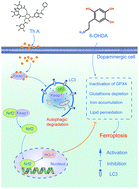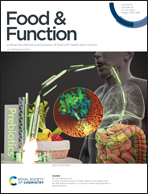Activation of Atg7-dependent autophagy by a novel inhibitor of the Keap1–Nrf2 protein–protein interaction from Penthorum chinense Pursh. attenuates 6-hydroxydopamine-induced ferroptosis in zebrafish and dopaminergic neurons†
Abstract
The death of dopaminergic neurons is a dominant factor during the occurrence and development of Parkinson's disease (PD). Previous studies demonstrated that ferroptosis is implicated in the death of dopaminergic neurons. Besides, polyphenols have been proven to be effective in preventing the death of dopaminergic neurons. This work aims to explore the neuroprotective effect and mechanism of thonningianin A (Th A), a polyphenolic compound in natural plant foods, against 6-hydroxydopamine (6-OHDA)-induced ferroptosis in dopaminergic cells. The results of molecular docking and other binding assays collectively demonstrated that Th A can strongly target the Kelch domain of Keap1. Th A treatment significantly facilitated the nuclear factor erythroid 2-like 2 (Nrf2) nuclear translocation and subsequently increased the heme oxygenase-1 (HO-1) protein level through inhibiting the protein–protein interaction (PPI) of Keap1 and Nrf2. Compared with the nomifensine (Nomi) treatment, Th A had a more potent protective effect on 6-OHDA-induced ferroptosis during PD pathology in zebrafish, which was associated with assuaging the reduction of the total swimming distance, glutathione (GSH) depletion, iron accumulation, lipid peroxidation, and aggregation of α-synuclein (α-syn). Furthermore, Th A also exhibited a strong protective effect against 6-OHDA-induced ferroptosis in vitro in the human neuroblastoma cell line SH-SY5Y. Th A degraded Keap1 protein through activating Atg7-dependent autophagy. Additionally, Th A treatment facilitated the degradation of Keap1 protein by promoting the interaction between p62/SQSTM1 (sequestosome 1, hereafter referred to as p62) and Keap1. Taken together, our findings indicated that Th A protects dopaminergic cells against 6-OHDA-induced ferroptosis through activating the Nrf2-based cytoprotective system, thus enabling a potential application of Keap1–Nrf2 PPI inhibitors in the restraint of ferroptosis and treatment of PD.



 Please wait while we load your content...
Please wait while we load your content...